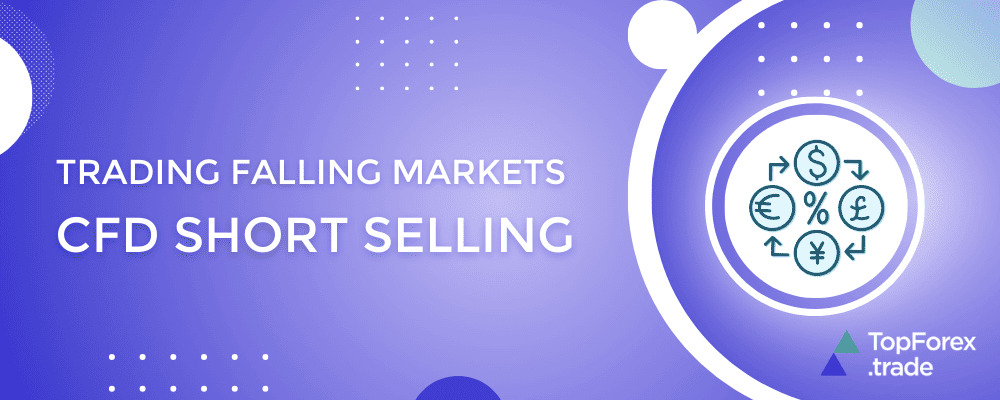CFD short selling: strategies to use for trading falling markets

Obviously, in financial markets, prices don’t always rise—sometimes they fall, and these downturns are not a bad thing as they can create unique opportunities for traders. A falling market, often referred to as a bearish market, occurs when the price of assets such as stocks, indices, or commodities declines. While traditional investors might view falling markets as a threat, savvy traders see them as a chance to profit by playing against these assets.
One powerful tool for capitalizing on declining prices is Contracts for Difference (CFDs). CFDs allow traders to speculate on both upward and downward price movements without owning the underlying asset. This flexibility means you can potentially profit even when markets are falling—through a strategy known as short selling.
In this article, we’ll explain how short selling works using CFDs, outline the advantages of this approach, and provide insights into how traders can use CFDs to turn falling markets into profit opportunities.
What is short selling?

Short selling is a trading strategy that allows you to profit from falling prices. In simple terms, it involves selling an asset you don’t currently own to buy it back later at a lower price. The difference between the sell price and the lower buy-back price becomes your profit.
To visualize this, imagine you borrow an asset—like a stock—when it’s priced at $100. You immediately sell it at that price. If the price drops to $80, you buy the stock back and return it to the lender. In this case, you keep the $20 difference as profit ($100 – $80).
— Example:
Let’s say you believe a company’s stock is overpriced and will soon fall.
- You “sell short” 10 shares at $50 each, earning $500 initially.
- The stock price falls to $40.
- You buy back the 10 shares at $40 each, costing $400.
- Your profit is $100 ($500 – $400), minus any fees.
This strategy works the same way with CFDs, but instead of borrowing or owning the asset, you simply speculate on its price movements. CFDs make short selling faster and more accessible, especially in volatile markets.
How to use CFDs for short-selling

When you short sell using CFDs, you agree with a broker to exchange the difference in the asset’s price between the time you open and close your trade.
- Open a sell (short) position
- You place a “sell” order with your broker when you believe the asset’s price will fall. At this point, you “borrow” the asset virtually through the CFD contract.
- Monitor the price movement
- If the asset’s price drops as expected, the difference between the sell price and the lower buy-back price becomes your profit.
- Close the position
- To secure your profit, you close the trade by placing a “buy” order at the lower price.
Example: profiting from a falling price with CFDs
Let’s say you believe the price of Company XYZ’s stock will decline.
- You open a short (sell) CFD position at $100 per share. You trade 10 CFDs, so your position is worth $1,000 (10 x $100).
- The price of the stock falls to $90 per share.
- You close the position by buying back the CFDs at $90 per share. The total buy-back cost is $900 (10 x $90).
— Profit calculation:
- Sell price: $1,000
- Buy-back price: $900
- Profit = $1,000 – $900 = $100
If the price had risen instead, you would incur a loss equivalent to the difference in price movements.
Why trade falling markets with CFDs?
Flexibility to trade both rising and falling markets
Unlike traditional investments that rely solely on rising prices to generate returns, CFDs allow you to profit in any market direction. You can:
- Go long (buy) when you expect prices to rise.
- Go short (sell) when you anticipate prices will fall.
This flexibility allows you to take advantage of market volatility and turn downturns into profit opportunities.
Leverage to maximize exposure with limited capital
CFDs are leveraged products, meaning you only need to deposit a fraction of the trade’s full value to open a position. Leverage allows you to control larger positions and potentially amplify your profits.
— Example:
With a leverage ratio of 10:1, you can open a $1,000 short position with just $100 of your own capital.
Note: While leverage magnifies profits, it also increases the risk of losses. It’s crucial to use leverage responsibly and manage risk carefully.
Access to various markets
CFDs provide access to a wide range of markets, allowing you to short sell:
- Stocks: Speculate on individual companies’ share prices.
- Indices: Trade major indices like the S&P 500, FTSE 100, or DAX 40.
- Forex: Profit from falling currency pairs.
- Commodities: Short sell commodities like oil, gold, or natural gas.
This versatility ensures that traders can find opportunities across different asset classes, even during economic downturns or sector-specific slumps.
Strategies for profiting from falling markets
Follow trends and use Technical indicators
Markets often move in trends, and recognizing a downtrend can help you time your short-selling opportunities. Use technical analysis tools to identify bearish signals:
- Moving Averages: When a shorter-term moving average (e.g., 50-day) crosses below a longer-term moving average (e.g., 200-day), it’s often a sign of a downward trend (known as the death cross).
- Support and Resistance: If prices break below a key support level, it could indicate further declines. Traders can open short positions to capitalize on the drop.
- RSI (Relative Strength Index): A high RSI (above 70) suggests an overbought market, which could soon reverse.
— Example:
If a stock consistently forms lower highs and lower lows, it signals a bearish trend. A trader can enter a short CFD position to profit from the expected decline.
Trade during news events or market downturns
Market volatility often spikes during economic reports, earnings announcements, or geopolitical events. Negative news can trigger sharp price declines, creating opportunities for short-selling CFDs.
- Earnings Reports: If a company posts disappointing results, its stock price may fall rapidly.
- Economic Data: Weak economic indicators like rising unemployment or falling GDP can negatively impact indices or currencies.
- Global Events: Political uncertainty or unexpected crises can drive commodities, stocks, or forex pairs lower.
Tip: Stay informed and watch for major news releases on economic calendars to anticipate market moves.
Set Stop-Loss orders to manage risks
Short selling can be highly profitable, but it also carries risks—particularly because prices can theoretically rise indefinitely. To protect your capital:
- Use Stop-Loss Orders: Set an automatic order to close your trade if the price moves against you. For example, if you short a stock at $100, you might place a stop-loss at $105 to limit potential losses.
- Position Sizing: Avoid risking too much of your capital on a single trade. Use smaller position sizes to manage exposure.
Combining stop-loss orders with disciplined risk management ensures you can pursue opportunities in falling markets without exposing yourself to unnecessary risk.
By following trends, using technical indicators, and trading during volatile news events, you can identify and act on opportunities in falling markets. When paired with stop-loss orders and sound risk management, these strategies allow you to confidently navigate bearish conditions and profit with CFDs.
Top brokers for short selling with CFDs

To effectively profit from falling markets using CFDs, it’s essential to choose a reliable broker that offers the right tools, conditions, and support for CFD trading. Here are some of the top brokers for short selling CFDs, along with their key benefits:
Plus500
- Competitive Spreads: Plus500 offers tight spreads, ensuring lower trading costs for short-selling opportunities.
- Leverage Options: Access to leverage allows you to amplify exposure with a smaller capital outlay.
- User-Friendly Platform: Its intuitive trading interface makes it ideal for both beginners and experienced traders.
- Market Access: Trade a wide range of CFDs, including stocks, indices, forex, and commodities.
XTB
- Low-Cost Trading: XTB provides competitive spreads and low commissions, which is beneficial for frequent traders.
- Advanced Trading Tools: The xStation platform offers advanced charting tools, technical indicators, and real-time market analysis.
- Leverage Flexibility: Choose leverage levels to suit your risk tolerance and strategy.
- Multi-Market Access: Trade CFDs on stocks, forex pairs, indices, and commodities, allowing you to capitalize on various falling markets.
Exness
- High Leverage: Exness offers some of the highest leverage options available, giving traders greater flexibility.
- Tight Spreads: Benefit from minimal spreads, helping reduce trading costs.
- Fast Execution: Exness ensures quick trade execution, which is crucial for short-selling in volatile markets.
- Diverse Markets: Access CFDs on stocks, indices, forex, and commodities to trade global opportunities.
NAGA Markets
- Social Trading Features: Naga Markets allows you to copy strategies from experienced traders, making it easier for beginners to start short selling.
- Competitive Spreads and Commissions: Enjoy cost-efficient trading conditions.
- Multiple Markets: Trade CFDs on stocks, indices, forex, and cryptocurrencies.
- User-Friendly Platform: A straightforward and easy-to-navigate platform that caters to traders of all levels.
HF Markets (HFM)
- Low Trading Costs: HF Markets offers competitive spreads and zero-commission trading on select accounts.
- Flexible Leverage: Take advantage of tailored leverage options to suit your short-selling strategy.
- Wide Range of CFDs: Trade CFDs on global stocks, forex, indices, and commodities.
- Educational Support: HF Markets provides tools, webinars, and resources to help traders understand and capitalize on bearish markets.
When selecting a broker for short selling with CFDs, consider factors like spreads, leverage options, trading platforms, and market access. Brokers like Plus500, XTB, Exness, NAGA Markets, and HF Markets provide the tools and resources needed to successfully navigate falling markets and profit from price declines.
By using a trusted broker, you can trade with confidence, knowing you have access to competitive conditions and a seamless trading experience.
Related articles:
How to trade falling markets with CFDs - FAQ

